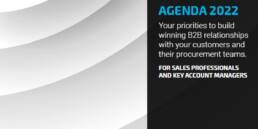“Dear valued supplier, we are delighted to inform you that our procurement function is, as of immediately, serving as your single point of contact for your sales teams for all product, sales and service negotiations, contract discussions and renewals.”
Starting to get sweaty palms?
You are not alone.
More and more sales teams around the world and across industries are in a state of shock it seems as they are starting to see professional procurement organizations taking over the interaction with them, the selection, negotiation and contracting of products and services that previously were directly handled by the end user for, practically, ever. Indeed, a dramatic change if your sales teams are not prepared!
Professional procurement teams buy in the best interest of their company, in the most effective and efficient way possible and according to the real needs the internal user or stakeholder/function actually has. For instance, a stakeholder wants a washing machine, which is a want. But what is the underlying need? They most likely need clean clothes – and there are other (better) ways to get your clothes cleaned, e.g. by having it washed at an external cleaning provider (outsourcing the process) opposed to purchasing a washing machine (inhouse process). The bottom line of this very simple example? Procurement is tasked to identify the real underlying company needs of their internal stakeholders and to cater for them accordingly. Over are the times of “wants”.
But why? And why now?
For a good 25 years already, major companies have built and tasked their procurement functions to manage and control the sourcing process, end to end, for their main so called spend areas, i.e. key ingredients and products or services the organization requires to operate. The areas of influence, or spend areas, under procurement’s management have been expanding rapidly though over the past decade. Why is that?
There are many reasons why organizations start to upscale and further professionalize their procurement function by handing over more budget ownership, and ultimately decision power, from the “internal user” to their procurement teams which are often referred to as an “internal service organization”. Here are some of the main reasons why procurement is gaining more power:
- The realization of senior leaders that buying is a professional skill that requires experts, training and experience.
- The realization of leadership teams that a good portion of their P&L is not under control (not auditable and hence prone to fraud and bribery) – i.e. no contracts in place, no price agreements in place, no documented decision processes in place, etc.
- The magnitude of so called “spend creep” that becomes more and more obvious in the P&L. Certain spend areas seem to be going up year over year alongside with proliferation of the supplier base which results in a significant administrative burden without anyone seeming to know why and how to counter this.
- The acknowledgement by senior leadership teams of the tangible value procurement has generated over the past decades and hence the trust and reputation that allows procurement now to ask for more responsibility.
- The urgency with which senior leaders need to act to control spend within the company to be able to manage risk, fulfill shareholder and regulatory requirements and financial control standards.
- The omnipresent pressure for CEOs and CFOs to improve operating profits and hence reduce costs.
- A realization of limited innovation in certain spend areas that are not managed by procurement mainly due to complacency and a comfort mode attitude by respective providers.
You might ask, but why this sudden increase in procurement activity in certain segments? The reasons were as strong 10-15 years ago as they are today. True! Though, the trust in procurement and market pressures have changed over time. The fact of the matter is, if a company today is not controlling its spend to a 100% through a procurement function, it is at a significant competitive disadvantage vs. their competition and the organization will need to catch up urgently. Studies have confirmed that product and service costs for companies that have professional buyers in place, are significantly lower than those that do not have such an internal service function (check The Hackett Group for more information).
Another reason for a slow roll-out of spend management in certain areas is: internal politics, functional egos and weak top leadership teams. Every functional leader is convinced that he or she can buy what they want themselves. “How difficult can it be? I have bought a carpet for my house the other day and got a good deal. I don’t need a buyer telling me what I need and how to buy it.” These attitudes and mindsets require organizational leadership and change management skills, as well as a trusted professional procurement function that knows how to reduce the perceived “angst” of functional leaders to lose control.
So, should I get sweaty palms as a sales person then?
Now, the question is, is procurement a threat for you as a sales person? This new reality of dealing with a professional buyer instead of, let’s say, an IT director directly as you done in the past.
The answer to this question is, it depends what has happened up to this very point. How did you treat your client?
The initial most common reaction I have repeatedly encountered over the years is that sales teams that find themselves in this very situation are indeed in a state of shock. What follows is a reduction in price and fees. Immediately and as soon as they are confronted (in the first meeting even) with the professional procurement person of their client.
Being a procurement professional myself, I am so certain and confident about this initial reaction by sales people that if a CEO would phone me up today with the request to manage a spend area that has never been under procurement’s responsibility before, I would instantaneously, and fully, commit to delivering a 20-30% decrease in cost! I was actually called into a meeting by an IT department one day and following a CEO directive that all IT expenditures would need to be channeled through my procurement team as of immediately. I had literally 5 minutes to prepare for this meeting which turned out to be a contract renewal negotiation for IT services. My pure presence in the meeting, in which I arguably contributed very little since I did not know much about the product, resulted in a 20% price concession by the sales person.
How should I react as a sales professional when I meet up with procurement for the first time?
I can only strongly recommend putting your A-team onto your customer’s account – ASAP. Next, you need to be honest to yourself and assess what has happened in the past with this client: have you been enjoying the ride and indeed been overcharging and underdelivering?
There is no hiding any longer because the buyer will find out. As procurement professionals, we are trained to become industry experts in the categories that we are owning and managing. So, if you sell telephone devices to me, I will be able to tell you what your price should be compared to where the market is, maybe not on day one but rather sooner than later – promised. An immediate price drop to appease me is well appreciated and I won’t say no, but it is indeed totally counter-productive. Anyone that is in the position to lower their price in the first meeting cannot be credible and trustworthy. In this situation, I would probably agree to a short-term deal to take advantage of the price reduction but probably deselect you, the seller, after our contract expired because trust is completely gone.
My advice is – be honest. You most likely have delivered against a want and not a need with your clients over the past years. Tell your buyer that there has been a level of complacency on this account for a certain period of time (probably ever) but that you are going to turn things around and that you will deliver stellar results above and beyond price: e.g. service levels, new innovation, additional solutions that drive sales and growth for my company, sustainability claims, etc. Find out what your competition is doing and find a way to create additional value. For this you will need to understand the customer’s and buyer’s needs fully though. You will need to rebuild trust and you will need to ask for a fresh start. This is a challenging position to be in and proper skills are required to safe-guard your position. You need to make up for your complacency (and I am afraid that is what it was), fast! Procurement people are impatient but at the same time not only focused on costs. They want to deliver excellent service to their internal customers – consistently.
The Procurement KPIs
Top notch procurement teams focus on driving sales and enabling growth for their organizations.
Have you realized something in this statement? – no mentioning of costs, savings or price. Professional buyers have understood that a price increase that results in higher sales (e.g. through increased quality, reduced lead time, better sustainability, etc.) is actually something very positive. Ultimately, in the end consumer’s and hence the internal stakeholder’s mind success is no longer just about a reduction in price. Many more forces and factors are at play. Costs need to be controlled, don’t get me wrong, but risk management, innovation, leveraging your external skills with your customer’s internal needs – that is where the real value is and this where YOUR SALES team CAN WIN with PROCUREMENT.
Embrace the challenge and start building trust and value with your buyer – today!
Written by Jens Hentschel, Founder & CEO of THE FIVIS PARTNERSHIP. The Consultancy That Gets You Your Oomph Back. Find out more at www.fivis.io.


